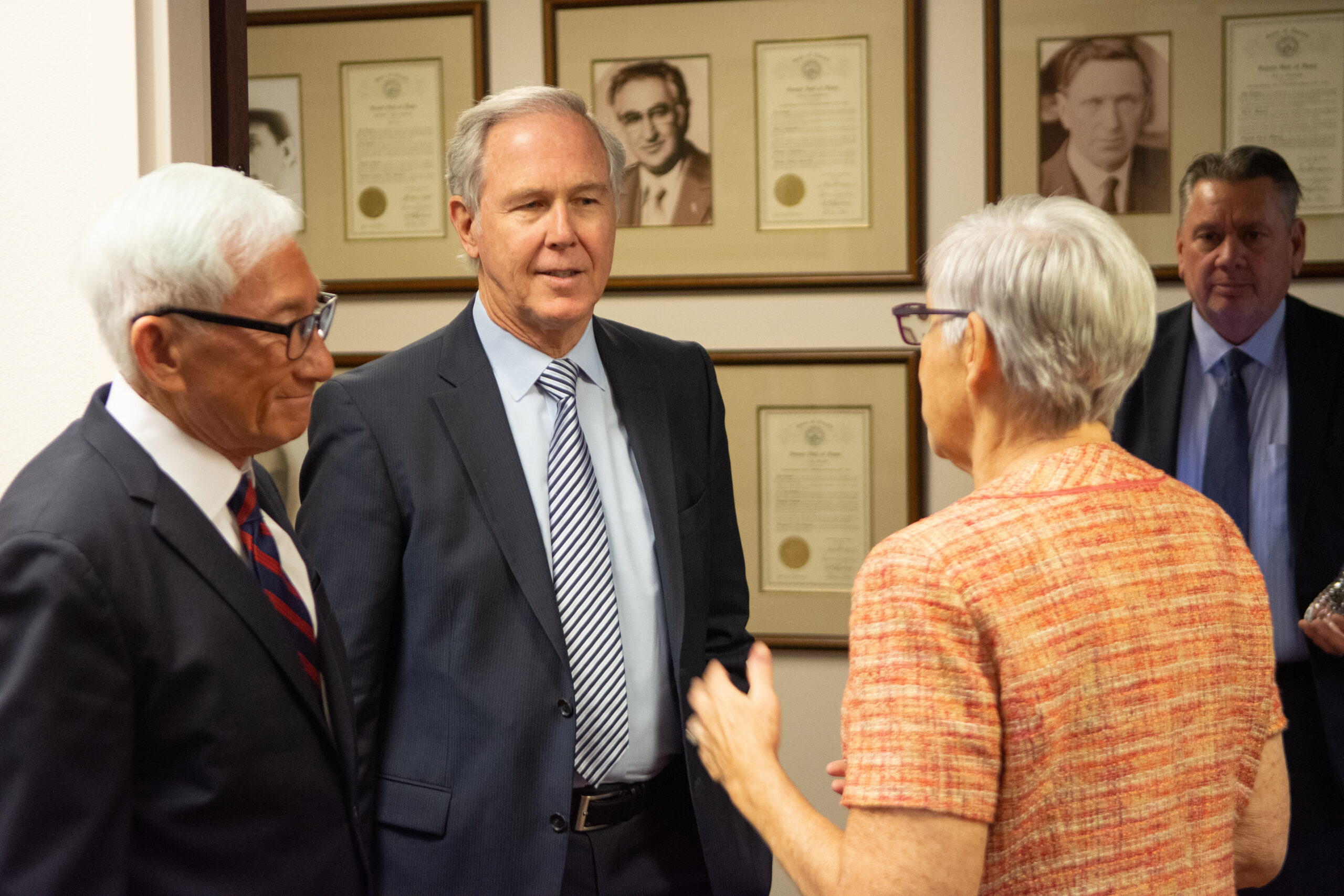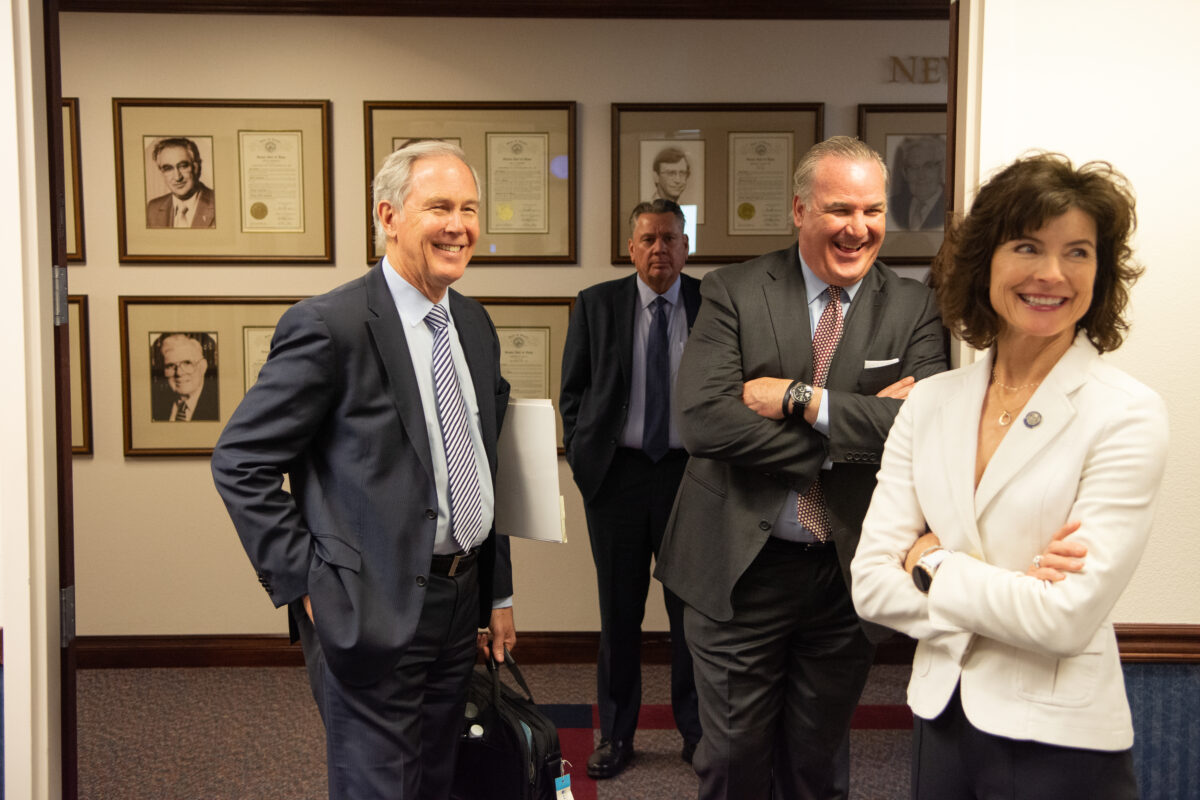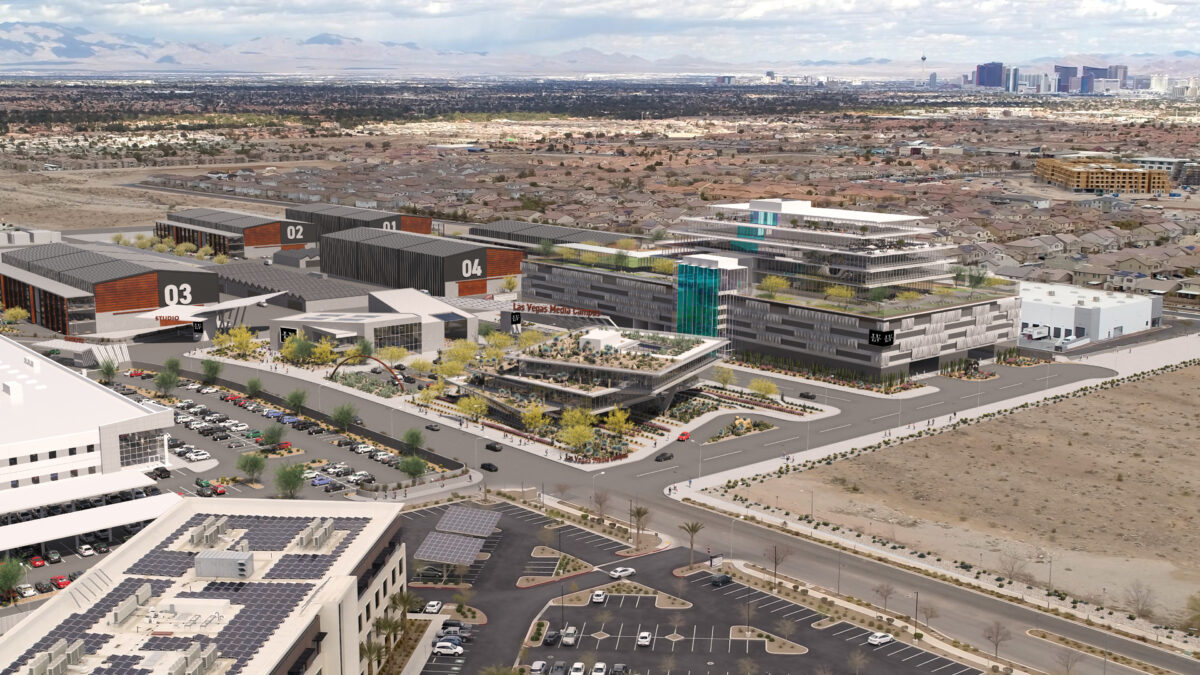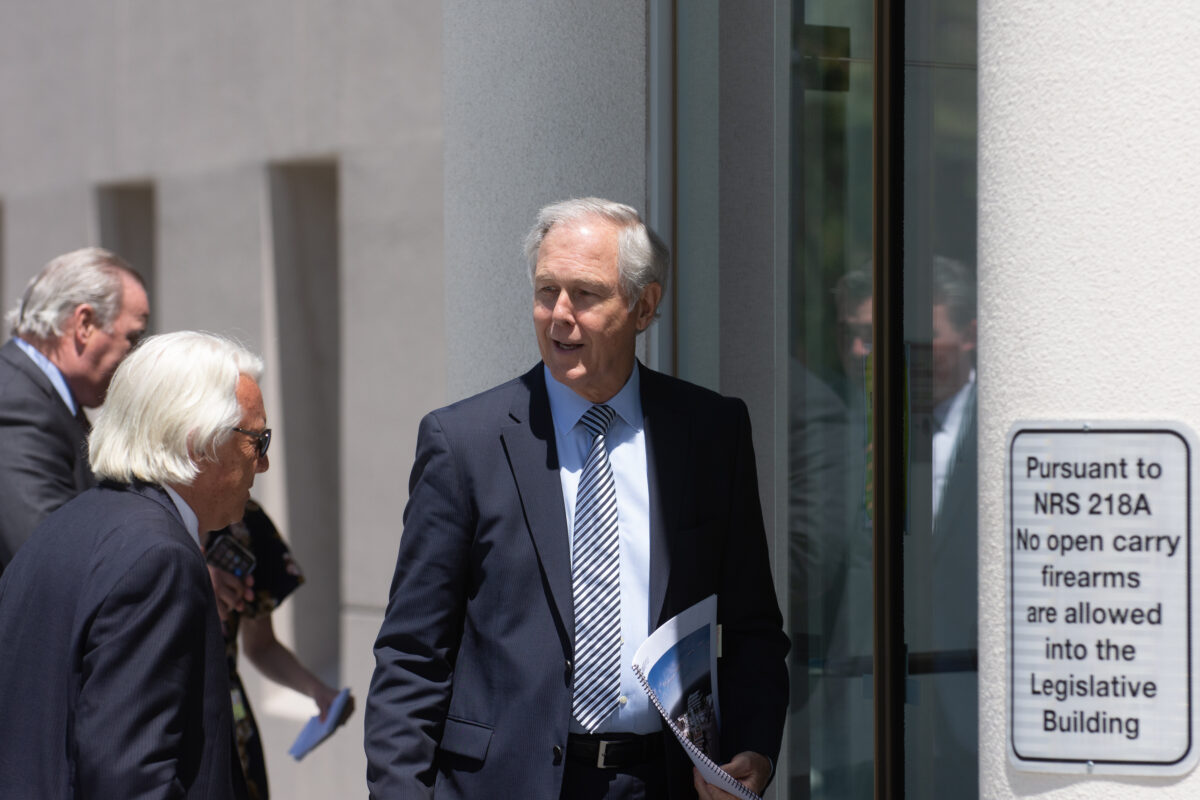Proposed massive expansion of film tax credits aims to attract industry to Vegas

In an effort to diversify Nevada’s economy and attract a larger share of the film industry, state lawmakers introduced a long-in-the-works bill Thursday that would significantly expand a film tax credit program aimed at bringing Hollywood to Las Vegas.
The bill, SB496, proposes up to $190 million in annual film tax credits over more than two decades, with credits primarily earmarked for a pair of new major production campuses in Las Vegas, which backers estimate will cost upwards of $1 billion to develop. The available amount of transferable tax credits would begin at $55 million annually and rise based on the total capital investment into the projects. The amount of annual credits available for a 20 year period would also increase based on the annual inflation rate.
Based on the timelines for development and expiry of the credits, if productions qualify for the maximum amount of credits annually, the state could issue upward of $4 billion in film transferable tax credits over the next 30 years.
With discussions of the legislation in the works for more than two years, this legislative session was expected to bring an expansion of the state’s film tax credits. However, negotiations occurred largely in secret, and a formal bill was only introduced Thursday. Lawmakers now have less than a month before the end of the session to decide on the proposed massive expansion of Nevada’s film tax credit program that could far exceed the state’s past use of transferable tax credits.
Alongside bill sponsor Sen. Roberta Lange (D-Las Vegas), the primary backers of the bill include Sony Pictures Entertainment, Southern California-based developer Birtcher Development and the Howard Hughes Corp., the developer behind the Summerlin community in the Las Vegas Valley.
Lange told The Nevada Independent in an interview Thursday that the huge expansion of the film tax credit program is a necessary investment for what she characterized as the creation of an entirely new industry in Nevada.
“To create that industry and make it last in the long term, it doesn't happen in a year, two years or five years or 10 years, it’s going to take 20 years,” Lange said. “In everything that we've done, all the research of the financials, the investment that will come back to Nevada far covers that amount of money.”
The two proposed real estate developments envisioned by the bill are the “Summerlin Production Studios Project” — where the Howard Hughes Corp. is expected to lead development in partnership with Sony — and the “Las Vegas Media Campus Project” developed by Birtcher Development at the Harry Reid Research and Technology Park on UNLV’s campus. No studio partner has come along at this point for the UNLV site.
A third component of the bill would create the Nevada Media and Related Technology Education and Vocational Fund, ostensibly designed to create a workforce development pipeline between the state’s higher education institutions and the film industry.
Lange said that she talked to Gov. Joe Lombardo at the beginning of the session and he seemed “excited” about the measure, but said he couldn’t make a commitment to support the bill until it came across his desk.
“There's a lot of interest, I'm not gonna speak for him, but I think that he would say that the Legislature needs to do their work,” Lange said.
Though the governor’s office declined to comment on the legislation, two Senate Republicans, Sen. Heidi Seevers Gansert (R-Reno) and Sen. Scott Hammond (R-Las Vegas), have already signed on as co-sponsors to the legislation. The bill does not create any new taxes and does not require a two-thirds majority vote to pass.
“When I look at Northern Nevada, we've been extremely successful in diversifying our economy,” Seevers Gansert said in an interview. “We brought in a number of businesses that really triggered this diversification and when you look at Southern Nevada, their main driver of their economy, as well as the state, is hospitality. And I think it's important for us to support economic development diversification in the south; it's good for the entire state.”
In an interview Thursday afternoon, Birtcher Development CEO Brandon Birtcher said the bill would create permanent long-term studio infrastructure for expanding “content creation” — ranging from scripted movies to video games to other forms of media. He added the measure would align with Lombardo’s stated goals of economic diversification and workforce development.
“The thing that's important to us is to create a community that's going to allow Nevada to get through the next pandemic, or whatever strikes us,” Birtcher said. “We've been more diversified with a new vision for labor that is unrelated directly with a very successful hospitality and gaming industry here in Nevada.”
A spokesperson for Culver City, California-based Sony Pictures said in a statement to The Nevada Independent that the company supports expanding its film and television production in Nevada, but such a move hinges on passage of the proposed tax credits.
“Working with The Howard Hughes Corporation and Birtcher Development and pending the passage of legislation guaranteeing a competitive Nevada production incentive, [Sony Pictures] is prepared to commit up to $1 billion in production spend in Southern Nevada over the next 10 years,” the spokesperson said.

Tax credits
Of the $190 million available annually in film tax credits, $180 million represent new credits, including up to $40 million in annual credits that would be available immediately for the development of the Summerlin project. Lawmakers created the initial film tax credit program in 2013 as a pilot program (notably used by producers of Paul Blart Mall Cop 2) but pilfered the fund as part of the deal attracting Tesla to the state in 2014 before again funding the program in 2017.
Other credits would then become available if certain criteria are met for development of the two projects. The UNLV-located Las Vegas Media Campus Project would be eligible for up to $55 million in annual credits after $200 million of capital investment is expended and up to $95 million in annual credits after $500 million of capital investment is spent, which is expected by the end of the decade. The Summerlin project would be eligible for up to $80 million in annual credits after reaching $400 million in capital investment.
The tax credit programs totaling up to $95 million and $80 million would increase annually based on the inflation rate, beginning in 2031. If some tax credits are not awarded in a given year, they could be carried over and granted in the following year.
A large chunk of tax credits in the bill, identified as “film infrastructure transferable tax credits,” are meant to ensure there are facilities in place for year-round production.
Also accounted for in the $190 million pot is $15 million in “noninfrastructure transferable tax credits” for any production, regardless of whether they are at one of the two new production campuses. That would be up $5 million from the existing limit on such credits in state law, which prohibits the state from issuing more than $10 million in transferable tax credits for all film productions in a single year.
For companies seeking the tax credits, the bill raises the amount issued to a production company from 15 percent to 30 percent of qualified expenditures, which include costs for set construction, wardrobe and makeup, filming and editing.
Individual productions at the two new developments could also be eligible for significantly more credits than allowed under Nevada law (capped at $6 million per production), up to $10 million for individual television episodes and up to $30 million for motion pictures. But the bill would also allow the leaders of the two Las Vegas projects to exempt a production from the cap.
Though California remains a dominant force in the film production space, with major studios headquartered in Southern California, supporters say the bill is meant to allow Nevada to compete with other states, such as Georgia, that have attracted production away from Hollywood by offering greater amounts of tax credits.
“In order to be competitive with other states that are doing film, we have to raise the bar,” Lange said.
Alongside an expansion of tax credits, proponents argued Southern Nevada’s proximity to Southern California gives it a competitive edge in drawing productions to the area.
“We will be the closest tax credit opportunity to the film production capital of the world,” Birtcher said.
Since 2011, Nevada has seen roughly 400-500 productions annually, which have generated between $34 million and $96 million in revenue for the state, according to an annual report from the Governor’s Office of Economic Development.
Transferable tax credits have long existed as an economic development tool to promote film production. Georgia, which offers transferable credits, has no annual cap on credits, and has issued record amounts of film tax credits in 2021 and 2022, totaling $1.2 billion and $1.3 billion, respectively.

Transferable tax credits can be sold from a recipient to another taxpayer. If a company has more in credits than it owes in taxes, selling credits can provide that company with a way to earn cash, while providing a buyer to purchase credits that offset its tax liability for potentially less money.
Under the bill, the credits can be used against the Modified Business Tax (a tax on payroll), insurance premium tax or gaming license fees. Nevada gaming companies have previously taken advantage of purchasing such credits, including MGM, which bought credits from Tesla, an electric vehicle manufacturer that received nearly $200 million in transferable tax credits through a landmark tax package approved in 2014.
Nevada’s $10 million annual cap on film tax credits puts it well behind several other states with similar programs, though the transferable tax credits provided by the state are more flexible than in many other states, where credits may not be transferable or rebates are instead provided.
Though Nevada’s existing film tax credits are nonrefundable, the bill would allow for refundable credits, meaning companies with credits that exceed their tax liability can trade excess credits for cash.
For example, if a production company owes $10 million in business payroll taxes and is awarded $15 million in film infrastructure transferable tax credits, the state would be on the hook for paying the company a $5 million cash refund. That means if film tax credits issued by the state exceed taxes owed by the recipients, the state would owe money from the general fund to pay for the credits.
Development of the projects
Birtcher said his company has been “working on this for four years,” and Lange said she’s been working on the proposal for more than two years.
Alongside the developers and Sony Pictures, the various entities involved with the project include UNLV, which owns the land on which one of the proposed campuses will sit.
Under the bill, the UNLV-area Las Vegas Media Campus Project requires a capital investment of at least $200 million by the end of 2027 and at least $500 million by the end of 2029 in order for a tax credit portion of the bill to kick in. The bill also calls for a minimum capital investment of at least $150 million at the Summerlin Production Studios Project by the end of 2027 and at least $400 million by the end of 2029 before the credits can be increased and extended.

Birtcher estimated that if passed, the project would create approximately 8,000 to 10,000 union jobs over the next five years between the two studios. In addition to that, he said the project would create another roughly 16,000 jobs once the industry is up and running at the two production sites. He said those numbers are based on two economic analysis reports that were not immediately provided by bill proponents.
In response to concerns about whether the film tax credit program would potentially lead to negative housing or other development consequences, such as those produced by the 2014 Tesla deal, Birtcher said both proposed zones are focused on developing and growing a local workforce.
“We have got unbelievable new housing developments being done all up and down Sunset (Road) and over in the UnCommons,” Birtcher said. “Infrastructure’s coming.”
Lange said the project will take time to get off the ground, giving lawmakers the ability to navigate any problems.
“This isn't something that's going to happen immediately, it's going to take permitting time, which will be about a year to 18 months. And then I think we'll go into the building timeframe,” Lange said. “I think it's by 2026 … that we'll eventually get started. I think we have time to have those conversations as we move forward.”
As tax credit programs have grown in size and popularity, some states have expressed concerns that the incentives don’t outweigh the costs.
A 2010 analysis of film subsidies from the progressive-leaning Center on Budget and Policy Priorities indicates that subsidies result in “not much bang for too many bucks.”
The report indicated that subsidies reward companies for production they may have done regardless of incentives, the best jobs usually are allocated for nonstate residents and the cost of subsidies outweigh the revenue generated, among other problems.
“State governments cannot afford to fritter away scarce public funds on film subsidies, or, for that matter, any other wasteful tax break,” the report concluded. “On the contrary, policymakers should broaden the base of their taxes to create a fairer and more neutral tax system.”
However, backers of the bill are seeking to keep content creation in place in Southern Nevada through requirements for major capital investments and a long period for tax credits to remain available before the bill provisions expire. The proposed credits for the two major projects would not expire until 20 years after the Las Vegas Media Campus project reaches its first major landmark of at least $200 million in capital investment. That means credits could remain in place as late as 2048.
Birtcher told The Nevada Independent that the bill would create a workforce and educational pipeline in a geographic area significantly closer to the existing film industry than other tax-credit havens.
“Hollywood, and I'll call it Southern California, is the entertainment capital of the world — they have a vast talent pool, right? But it's aging not only in its infrastructure, but maybe getting a little bit long in the tooth when the way things have been done in the past,” Birtcher said.

Standing up workforce, education pipelines
Among the key promises made by proponents of SB496 is that it will “merge” the film industry in the state with UNLV through the creation of the “Nevada Media and Related Technology Education and Vocational Fund.”
That fund would be filled by 10 percent of the total tax credits, or $19 million a year assuming a full $190 million of tax credits. Of that money, 45 percent would be diverted to funding operations at the campus, including staff, while the remainder would be spent on educational programs.
That fund would then be governed by a seven-member board, composed of representatives from the studio zones, as well as appointed members from the governor and legislative leadership.
“So they [the board] will be representing this, and they meet semiannually to put the money to work at the school system level, from trade schools, grade schools, giving kids a passion and a vision for what they can do in all these different aspects of the industry,” Birtcher said.
Marta Meana, a former UNLV interim president and now strategic advisor to UNLV President Keith Whitfield who helped craft the university’s integration agreement as part of the broader deal, told The Nevada Independent that the project would involve not only educational programs at the College of Fine Arts and its film program, but also digital content creation arms that could stretch across engineering, computer science, medicine and gaming.
“With film industry infrastructure in place, we're going to be able to bring a whole slew of students, not just UNLV students, but students across the state in what we hope is going to be an emerging industry in Nevada,” Meana said. “This is not about some production company coming in and getting a tax credit to shoot a film and then leaving when they're done.”
It was not immediately clear how long it would take UNLV to stand up additional educational or workforce programs if the bill passes. However, Meana said the university would begin its integration “immediately.”
“One of the things that we wanted to do is to make sure that the integration started the minute that those shovels hit the ground,” Meana said. “So we're not waiting for the entire thing to be built out to start working together.”
Content produced through the project would be moderated according to certain film standards, and Birtcher said all parties agreed that no NC-17 content — the highest content rating provided by the Motion Picture Association above “R” — would be produced in either zone.
“None of that content is being created,” Birtcher said. “It's not allowed, it will be prohibited in the leases with our tenants.”
Asked if the money in the fund could be used for institutions outside of UNLV, up to and including programs at K-12 schools statewide, Lange said the board running the fund will be partnered with UNLV, though “that doesn’t mean we can’t diversify and go out, the board could probably make those choices.”
“But the money will come into the center to train for the pipeline, so that we have the jobs that we need to fill the positions that are going to open up because of this,” Lange said. “And look, I see us, I see UNLV becoming the [University of Southern California] — what USC has meant to Southern California, UNLV is going to mean that to Southern Nevada.”
Updated on 5/12/2023 at 7:45 a.m. to include additional details about proposed tax credits being refundable.


